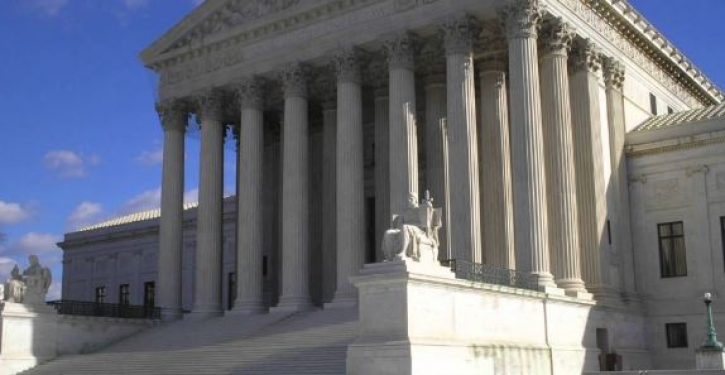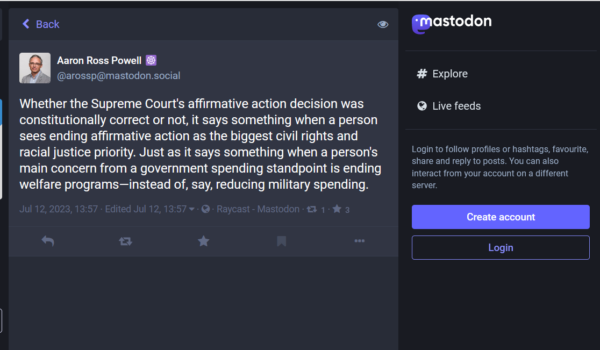
Recently, the Supreme Court restricted the use of race in college admissions, in response to lawsuits arguing that the University of North Carolina and Harvard University violated laws against racial discrimination, and the Constitution, by discriminating against whites and Asians in admissions.
In her dissent calling for colleges to be allowed to race in admissions, Justice Sonia Sotomayor argued that the University of North Carolina “excluded all people of color from its faculty and student body” for most of its history. But is this claim true? No, it is false, explains David E. Bernstein, a law professor at George Mason University: “UNC excluded African Americans until the civil rights revolution of the 1960s, but other ‘people of color,’ including Asians, Hispanics, and Native Americans, attended UNC. The first documented Asian student, for example, was a Japanese immigrant who matriculated at UNC in 1893,” he observes in the Wall Street Journal.
Elsewhere, he points out that “during the Jim Crow era, UNC … admitted Cherokee and Asian Americans, and there was no legal category of ‘Hispanic’ to exclude, as Hispanics were generally considered to be white, especially outside the southwest.”
Although neither UNC nor Harvard had a history of excluding Hispanics, they both tended to give Hispanics a preference in admissions over the last generation. Blacks receive much bigger racial preferences in admissions than Hispanics do, at least at these two schools.
Sotomayor also claimed that “Students of color…are disproportionately disciplined or suspended, interrupting their academic progress and increasing their risk of involvement with the criminal justice system.” But as Professor Bernstein notes, “In fact, Asian American students have less than 1/3 the rate of of school discipline than whites do.”
In their dissent, the three progressive justices made false claims about health disparities between blacks and whites, inaccurately claiming that black babies are much less likely to survive with a white physician (a claim debunked in the National Review, Daily Signal, and other sources), and falsely implying that racial minorities in general have shorter life spans than whites (in fact, Hispanics and Asians typically live longer than whites).
The Supreme Court’s ruling restricting racial preferences in admissions was a 6-to-3 ruling, with the justices appointed by Republicans in the majority, and the justices appointed by Democrats in the dissent.
The three dissenting justices simply ignored the plain language of the civil-rights laws, which ban racial discrimination against anyone, even whites and Asians. Racial discrimination in college admissions violates Title VI of the Civil Rights Act, which states that “No person in the United States shall, on the ground of race, color, or national origin, be excluded from participation in, be denied the benefits of, or be subjected to discrimination under any program or activity receiving Federal financial assistance.
Justice Ketanji Brown Jackson claimed in her dissent, which was joined by Justices Elena Kagan and Sonia Sotomayor, “race-linked health inequities pervad[e] nearly every index of human health” resulting “in an overall reduced life expectancy for racial and ethnic minorities that cannot be explained by genetics.”
That was a false statement. In reality, Hispanics live longer than whites on average, and Asians live significantly longer than whites. Whites, in turn, live longer than blacks. If you combine blacks and Hispanics into one minority category, then minorities’ life span is close to whites. If you add Asians into the minority category, minorities may actually live longer than whites.
But Justice Jackson’s dissent justified racial preferences in college admissions as a way of getting rid of gaps in things like life expectancy — even though Hispanics suffer no gap in life expectancy, but rather live longer than the average American, yet they often receive a racial preference in admissions to elite colleges like Harvard. As the Supreme Court noted, “in the Harvard admissions process,” “a significant percentage ‘of all admitted African American and Hispanic applicants” are admitted because of their race.
If colleges can use race in admissions because “race-based gaps exist,” as Justice Jackson argued in her dissent, then colleges will be able to use race forever, because race-based gaps exist in every country on Earth, for reasons unrelated to racism. They exist even in countries where people were never enslaved based on their race, and segregation never existed. Racial disparities exist everywhere in the world, often for non-racist reasons, notes the black economist Thomas Sowell in his book Discrimination and Disparities.
Many racial gaps are obviously not due to discrimination. Prior to the pandemic, Hispanics lived three years longer than whites, on average, even though doctors don’t discriminate in their favor. (Now, they still live longer, but the gap has shrunk by a year or so). Asians make more money than whites, on average. And while blacks make less money than whites, on average, African immigrants to America make more money than whites, showing that racism is not a major impediment to success.



